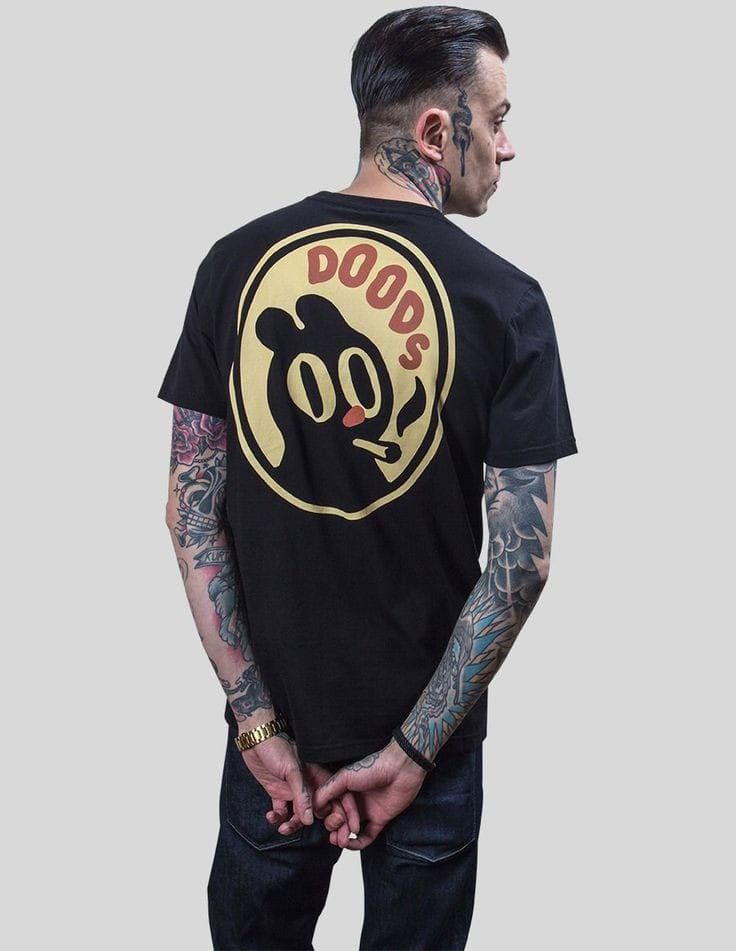
The Timeless T-shirt: From Practical Clothing to Cultural Icon
- No Comments
The Timeless T-shirt: From Practical Clothing to Cultural Icon
The T-shirt is a ubiquitous garment that has transcended its humble origins to become a symbol of modern culture, fashion, and self-expression. It is one of the most versatile and beloved items in the world of fashion, and its influence extends beyond the realm of style into social, political, and cultural movements. Despite being a seemingly simple piece of clothing, the T-shirt holds a powerful presence in both everyday life and the fashion industry.
Origins of the T-shirt: Humble Beginnings
The T-shirt’s history dates back to the early 20th century, with its earliest form emerging in the United States as an undergarment for soldiers during World War I. The lightweight cotton shirt, designed to be worn under a military uniform, was seen as a more comfortable alternative to the heavier, less breathable fabrics that were used at the time. The shirt’s practicality and comfort made it popular, and after the war, it quickly made its way into civilian life.
During the 1920s and 1930s, T-shirts were still largely worn as undergarments and were not yet a mainstream item of clothing. It was not until the late 1930s and early 1940s that the T-shirt began to gain popularity as an outer garment. In fact, it was often worn by laborers, workers, and sailors due to its breathable fabric and practical design. However, the T-shirt was still largely considered utilitarian rather than fashionable.
The 1950s: T-shirts Become Icons of Youth and Rebellion
The cultural significance of the T-shirt truly began to take shape during the 1950s. The decade witnessed a dramatic shift in youth culture, with the emergence of rock and roll, rebellious attitudes, and a desire for individuality among the younger generation. The T-shirt became synonymous with this new wave of youthful defiance, with Hollywood stars such as Marlon Brando and James Dean popularizing the garment in their iconic roles. Brando, in particular, wore a simple white T-shirt in the 1951 film A Streetcar Named Desire, making it a symbol of masculinity, rebellion, and casual coolness.
Similarly, James Dean’s portrayal of the brooding, misunderstood teenager in Rebel Without a Cause (1955) further cemented the T-shirt’s status as an emblem of youthful rebellion and independence. The T-shirt became the go-to garment for young people looking to express their nonconformity and distance themselves from the previous generation’s more formal and conservative fashion choices. These Hollywood icons helped transform the T-shirt from a functional piece of clothing into a cultural symbol.
The 1960s: The Rise of Political and Social T-shirts
By the 1960s, the T-shirt had undergone a transformation from a garment of rebellion to one of activism and social expression. The decade was marked by a variety of social movements, including the Civil Rights Movement, the anti-Vietnam War protests, and the feminist movement. As these movements gained traction, the T-shirt became a powerful tool for spreading political messages and rallying people to a cause.
Protest slogans and political statements began to appear on T-shirts, which allowed individuals to wear their beliefs on their sleeves—literally. One of the most iconic examples of this trend was the use of T-shirts in the Civil Rights Movement, where activists would wear shirts emblazoned with slogans such as “I Am a Man” during the Memphis Sanitation Workers’ Strike in 1968. The T-shirt became a vehicle for political expression, allowing people to publicly demonstrate their solidarity with various causes.
In addition to political activism, the 1960s saw the rise of the counterculture, which embraced the T-shirt as a symbol of nonconformity and individuality. The hippie movement, in particular, adopted the T-shirt as a staple of their style, with vibrant, tie-dye designs and peace symbols becoming popular motifs. T-shirts became a way to express one’s identity and beliefs, whether they were related to political issues, personal values, or simply an opposition to mainstream culture.
The 1970s: The T-shirt as a Canvas for Creativity
As the 1970s rolled in, the T-shirt continued to evolve in terms of both design and cultural significance. This decade marked the rise of graphic T-shirts, which became a blank canvas for artistic expression. In addition to political slogans and messages, T-shirts began to feature artistic designs, including bold graphics, band logos, and pop culture references.
Music played a significant role in the rise of graphic T-shirts during the 1970s. Rock bands, such as The Rolling Stones, Pink Floyd, and Led Zeppelin, became cultural icons, and their fans proudly displayed their loyalty by wearing band T-shirts. These T-shirts often featured album artwork or concert posters, turning the garment into a way for fans to show their affiliation with a particular artist or musical movement.
Moreover, the 1970s saw the rise of the concept of “branding” in the world of fashion. Companies like Nike and Adidas began to use T-shirts as a way to advertise their logos and products. T-shirts became a way to promote not just personal expression, but also consumer identity, as people began to wear clothing that represented their favorite brands and products.
The 1980s: T-shirts as Status Symbols and Pop Culture Icons
The 1980s ushered in a new era for the T-shirt, with the garment becoming not only a symbol of personal expression but also a status symbol. During this decade, fashion became increasingly commercialized, and the T-shirt was no longer just a functional item—it became a tool for branding, identity, and cultural affiliation. The rise of the MTV generation and the increasing influence of pop stars, athletes, and movie stars led to the T-shirt becoming a medium for self-promotion.
The 1980s saw the proliferation of graphic T-shirts with bold logos, catchphrases, and slogans, reflecting the era’s obsession with consumerism and celebrity culture. T-shirts emblazoned with the logos of popular brands like Nike, Coca-Cola, and Gucci became fashionable, signaling not only the wearer’s taste but also their status and lifestyle. Celebrities, such as Madonna, Michael Jackson, and Prince, were often seen wearing T-shirts adorned with their own names or likenesses, cementing the garment’s connection to fame and pop culture.
Additionally, the 1980s saw the rise of urban streetwear, with brands like Stüssy and Supreme making waves in the fashion world. These streetwear brands, often associated with skateboarding, hip-hop, and youth culture, helped redefine the T-shirt as a piece of casual, yet stylish, attire. T-shirts became a way for young people to align themselves with specific subcultures and movements, from skateboarding to hip-hop and punk.
The 1990s: The T-shirt Becomes a Canvas for Graphic Design
The 1990s saw the continuation of the trend of T-shirts as a form of self-expression, with graphic design reaching new heights. The era was marked by the rise of Internet culture, alternative rock music, and the continued influence of hip-hop and skateboarding subcultures. Graphic design on T-shirts became more intricate, with designers experimenting with color, typography, and imagery to create bold, eye-catching designs.
In the world of music, the 1990s witnessed the popularity of alternative rock bands like Nirvana, Pearl Jam, and Soundgarden. Fans of these bands proudly wore T-shirts with the band’s logo, album art, or catchphrases. The grunge movement, with its anti-establishment ethos, embraced the T-shirt as part of a uniform of rebellion. Vintage T-shirts, often featuring obscure bands or retro logos, became highly coveted, and T-shirt design became a way to capture the spirit of the times.
The 2000s: The T-shirt and Fast Fashion
By the 2000s, the T-shirt had firmly established itself as a wardrobe staple, available in an endless variety of styles, colors, and designs. The growth of fast fashion retailers such as H&M, Zara, and Forever 21 meant that T-shirts became even more affordable and accessible to the masses. These retailers mass-produced T-shirts with a wide range of designs, from simple solids to elaborate graphics, catering to the tastes of all types of consumers.
The rise of social media also had a profound impact on the T-shirt industry. Brands like Threadless and TeeSpring gave consumers the ability to design and print their own T-shirts, leading to a wave of personalized and customized shirts. As social media platforms like Instagram, Facebook, and Twitter became central to daily life, T-shirts increasingly became a way for people to express their individuality, their favorite pop culture references, and their personal beliefs.
Conclusion: The Enduring Legacy of the T-shirt
From its modest beginnings as a military undergarment to its current status as a global fashion icon, the T-shirt has come a long way. It has evolved from a simple, functional garment to a powerful form of self-expression, cultural commentary, and fashion innovation. Its widespread appeal lies in its versatility, comfort, and ability to communicate messages through design, color, and style.
As fashion continues to evolve, the T-shirt will undoubtedly remain an essential piece of clothing for people of all ages, backgrounds, and cultures. It is not just a piece of clothing; it is a canvas for personal expression, a symbol of cultural movements, and a reflection of the changing times. The T-shirt will continue to be an enduring staple in the world of fashion, forever adapting to new trends, technologies, and societal shifts.
Previous Post


T-Shirt: The Icon of Casual Fashion and Culture

The Ubiquity and Versatility of T-Shirts

The Evolution and Cultural Impact of the T-Shirt

T-Shirt: Effortless Style Starts Here

